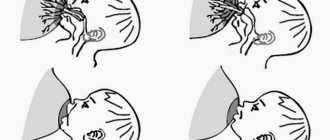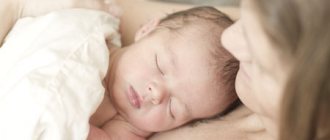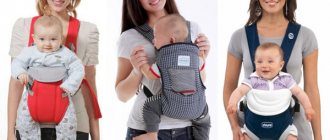Boys differ from girls not only externally, emotionally and physiologically. You need to know some specifics about caring for them so as not to cause harm with excessive care. Every mother needs to study information about boy hygiene, because a child’s penis is significantly different from that of an adult man.
Mom and baby
The need for newborn hygiene
Newborns need special hygiene. Their skin is very thin and delicate, so prolonged exposure to pollution often causes irritation and inflammation. Based on the fact that newborn children do not run around the streets, there is practically no contamination on their skin except waste products and milk, so babies do not need washcloths and sponges.
Everything you need to wash your newborn:
- warm water;
- baby soap;
- baby towel;
- baby cream
It is very important to pay attention not only to the obviously dirty areas under the diaper, but also to the areas on the neck. The folds between the chin and neck very often accumulate milk that the baby has burped or spilled. Due to the abundance of folds on the baby’s body, it is easy for such contaminants to hide from the watchful eye of the mother
Due to the abundance of folds on the baby's body, it is easy for such contaminants to hide from the watchful eye of the mother.
Important! If you do not wash the folds, bacteria develop very quickly in them, which causes an unpleasant odor, redness and pain.
Bath towel
The child must have his own towel, which no one else will use except him. It is better if it is large with a hood. It will last longer, and it will be easier for them to dry the baby after bathing. To wash your baby, it is better to have a separate small towel that absorbs well and is soft to the touch.
Taking good care of your skin
The skin of babies is very delicate. Therefore, it is recommended not to wipe, but to remove moisture with blotting movements using a terry towel.
After completing the washing procedure, it is necessary to treat the skin with cosmetic oil or powder. However, they cannot be combined, since the first product moisturizes dry skin, and the second one dries out diaper rash.
How to properly wash a newborn under the tap
Every time you change a diaper and after defecation, it is mandatory to wash the baby using a baby intimate hygiene product. If the baby has just passed a little, you can get by by washing it with running water.
In any case, prolonged washing of the baby in a bath or basin is not required. All you need to do is use the faucet in the bathroom. Washing a child's bottom under the tap should be done in the direction from the perineum to the sacrum, regardless of the gender of the baby. This will prevent feces from coming into contact with the genitals. You need to dry your baby after the water procedure with a soft, ironed towel.
Washing a newborn under the tap is best done together. If this is not possible, the parent should be as attentive as possible and ensure that the child is positioned in such a way that he is comfortable and the adult can freely perform all the necessary manipulations. The baby should not be in pain, and the possibility of the baby falling from the arm should be excluded. Not everyone succeeds the first time - the skill needs to be trained. If it doesn’t work out well yet, be sure to involve another adult in the procedure.
To avoid burning or overcooling the baby, you need to use a thermometer. If the device is missing, the folk method will help. To do this, you need to open the tap, adjust the water and place your elbow under the stream of water. If the sensations are comfortable and pleasant, you can wash the baby.
Even the smallest particles of contaminants should not remain on the skin. If fecal residues dry out, you must carefully remove them using a sterile cotton ball soaked in baby oil.
There are sponges on sale for washing babies that are recommended from birth. But don’t rush to buy them - you shouldn’t bother with washcloths for up to a year. Rubbing the thin skin of a baby does not have any benefit and can even cause harm due to aggressive effects.
Also be sure to wash your child every time before going to bed. Wet wipes should be used in exceptional cases - if there is no water nearby. For example, while walking, on the road. In all other cases, wiping should not replace proper washing.
Before the procedure, you should prepare all the required items: a new diaper, sterile cotton wool, cleaning products, wet wipes, a fresh towel, powder or cream. An adult must wash their hands thoroughly with soap.
Washing babies of both sexes has some peculiarities.
How to properly wash a boy
The nuances of boys’ intimate hygiene are related to the structural features of the body.
The washing technique is as follows.
- Place the baby on your arm, tummy down, with your back to the tap. The correct position of the child: the head is located on the elbow, the body lies on the mother’s hand, the legs hang down.
- Wash the butt and then the intimate area without pulling back the skin of the foreskin. In boys of the first year of life, the head of the penis is not yet fully formed. Forced exposure of the head can be painful and dangerous. As the child grows, the foreskin becomes mobile. You need to brush off dirt with soft stroking movements. More intense effects are not recommended. Rubbing can cause redness and microcracks on the skin.
- Dry the baby's clean skin with a towel.
- Leave the baby without a diaper for 5-10 minutes to allow any remaining moisture to dry naturally.
- Apply diaper cream or powder, put on a diaper and a fresh set of underwear.
How to properly wash a girl
The intimate area of girls is designed to create maximum protection from external influences and bacteria. Therefore, the parent’s task is only to wash away the impurities from the labia.
The washing technique is as follows.
- Place the baby with her back on her arm, facing the tap. The correct position of the child: the head and torso lie along the adult’s arm, the butt is firmly fixed on the palm, the legs hang down.
- Remove dirt with light movements from front to back. Dirt should be brushed off rather than scrubbed.
- Dry clean skin with a towel.
- Leave the newborn to breathe for 5-10 minutes without a diaper.
- Apply the cream, put on a diaper, dress the baby.
Immediately before bathing, the baby should be carefully placed on a changing table, bed or other horizontal surface, undressed, and the used diaper removed. If there is excess feces on the skin, they can be removed with a napkin or cotton wool, the remnants will be washed off with water. It is recommended to first place a disposable diaper on the bed or table.
Using Soap
You can use baby detergent in hygiene procedures, but only if the contamination is very strong. Often the use of soap is fraught with disruption of microflora and deterioration of the protective properties of the skin.
It should not contain cosmetic type fragrances. To prevent allergic manifestations, the soap should be thoroughly washed off, especially from the folds. Provide your baby with his own towel.
Caring for a boy after washing
After you have managed to wash your baby, you must treat the skin with cream. Previously, every mother always had powder on hand. It was applied to the skin and the child was dressed. Thanks to the zinc included in the composition, delicate skin was protected from prolonged exposure to urine. The need for powders was due to the lack of quality diapers on sale.
Today, the need to use bulk cosmetics has decreased significantly, but has not disappeared. With the advent of disposable diapers, some women no longer understand how many times a day their baby urinates. They see that it is time to change the linen only when it is already hanging to the ground from overfilling, and the child is chained to the crib like a weight. Not a single representative of disposable panties, even the highest quality, is capable of protecting a child’s skin from getting wet. Therefore, modern children develop diaper rash and dermatitis, which can be eliminated with the help of powder.
What to process
It is most reasonable to prevent the formation of irritations on the child’s skin. Therefore, pediatricians and dermatologists advise lubricating the area under the diaper with thick baby cream. It is better if it contains zinc; tubes with such creams usually have the “Zn” sign on them. The addition of a formula with this element in the cream provides reliable protection against getting wet. A dense layer of cream does not allow moisture to pass through to the skin, while simultaneously moisturizing it.
Every mother should think not only about how to wash her newborn, but also about what she will use to treat her delicate skin. After an evening bath, the child’s body must be treated with two different creams:
- containing zinc, for the area under the diaper;
- moisturizing, to treat the rest of the body.
Important! The choice of cream to apply to children's skin should not be based on the brightness of the packaging, loudness of the brand and price, but on its composition. You can buy an expensive cream with lavender extract from a famous manufacturer and get red allergic spots all over your body.
You can buy an inexpensive white cream in an unattractive tube, without fragrances or other additives, which will perfectly moisturize the skin without causing unpredictable skin reactions.
Mom and healthy baby
Every mother should know how to properly wash a baby boy. Excessive care for the genital organ causes more problems than it brings benefits. Nature reliably protects delicate tissue from infections, so you should not try to penetrate into places where physiology does not provide for it.
How to properly hold a newborn while bathing
After making sure that the water is at a normal temperature, you can start washing. The child is lowered into the water smoothly and slowly.
Attention! In the first days after the maternity hospital, it is best to lower the newborn in a diaper. This makes it easier to hold a slippery body
The baby should be immersed in water, holding the head and back of the head with his left hand, and his butt with his right hand. The newborn's head and neck should not be completely submerged in water. The baby should calm down a little.
Child immersion
Then they start washing. During this procedure, the head should lie on the left forearm, the back should be on the palm. The right hand is used for soaping. Particular care should be taken to wash the thigh folds, ears, armpits and groin. The face should be washed from a separate cup. Water from the tap should flow under medium pressure.
Another holding option is to place the head on your hand so that the part of it with the little finger supports the baby's neck. At the same time, a small folded diaper is placed underneath. It provides stability to the newborn.
Holding the baby's head
When washing, you can use a washcloth, but it is best to perform all actions using your hands. When bathing comes to an end, the child is turned over on his stomach and doused with clean water. It should be poured on the shoulders, not on the head.
After immersing the baby in the bath, you can support the head with your left hand. This way he will feel a little freedom in the bath. It will be pleasant and interesting for him to move his arms and legs in the water.
Water comfort
The temperature of the water should be perceived by the baby without stress. Too hot or too cold will not work.
The ideal option is parameters close to body temperature, i.e. about 36oC. It can be measured with a special thermometer or by placing your elbow in contact with water.
Ways to carry a newborn
Discussions about carrying children in our arms still do not subside. The opinions of experts are categorically divided. Some believe that the child should be carried as often as possible. Others, in particular, the famous pediatrician Dr. Komarovsky, claim that if you take a baby in your arms at the first call, you can raise a little manipulator. Mothers, based on their experience, believe that the truth is in the middle.
In the mother's arms, the child feels warmth, protection, and peace. He was only recently in the stomach, with his birth everything changed: new sensations, sounds, space. Mother's hugs return the baby to the familiar world. In addition, tactile communication brings the baby closer to the parents, and a relationship arises between them.
You need to know when to stop, seeing that the child does not want to “get off” almost all day, you should think about how to distract his attention: walk more in the stroller, rock in the cradle. How to carry a newborn? Easy and neat
The first rule is no need to be afraid. The child is not a crystal child, he is simply not yet strong enough. Movements should be smooth and confident
How to carry a newborn? Easy and neat. The first rule is no need to be afraid. The child is not a crystal child, he is simply not yet strong enough. Movements should be smooth and confident.
Basic poses:
Cradle. The most common position in the first weeks of a baby's life. The child is in a horizontal position, with his stomach slightly turned towards the adult. The head is fixed in the elbow bend, the back and butt are supported by the hand.
Cradle pose
On the stomach. The child is positioned horizontally, face down. The head is on the palms, the stomach, chest and butt are on the hand. The other hand supports the baby.
Stomach pose
In a column. The baby is positioned vertically. The head and neck are fixed with one hand, and the body is gently pressed against the adult with the other. The musculoskeletal system is not formed; stress on the spine must be avoided. In the first weeks of life, the position is used only for a few minutes after feeding. In this position, the baby burps, which reduces the accumulation of gases.
Column pose
Buddha. The baby is in a semi-sitting position with his back to the adult. The chest and neck area is fixed with one hand, and the legs are held with the other. Concentration of weight in the pelvic area should be avoided. It is advisable to use this position no earlier than one month of age.
Buddha pose
Advice. Throughout the day, it is recommended to change the position of the child, move him from one hand to the other, to avoid torticollis, numbness in the arms and legs.
What not to do when picking up your baby:
- Do not hold the head in any position.
- Do not fix the backrest in a vertical position.
- Lifting a baby by the wrists can cause dislocation.
- Allowing the legs to hang - there is a risk of developing dysplasia.
- Do not sit or put the child on his feet - the spine is bent.
In the first month after birth, you can lightly swaddle the baby - this will help secure it.
Using a sling
Features of bathing in a bath
For bathing, it is recommended to choose a bath that would be comfortable for the baby and his parents. It should be light. The ideal solution for baby washing is a compact and lightweight plastic bathtub. Enameled and ceramic products are not so convenient.
Bathing a child in a bathtub
It is best to place the bath on a table or other stable furniture. This will make bathing the baby easier. Since it can be quite difficult for beginners to hold newborns while bathing, it is necessary to choose the appropriate shape of the bath. Modern models have an elevation at head level. This will make it convenient for parents to control the position of the newborn.
Some parents find it difficult to hold a soapy baby. To protect against slipping, a diaper is used. It is recommended to place it in the bath as a comfortable and non-slip headrest, which will minimize the risk of injury.
Do I need to add anything to the water?
There is an opinion among mothers and grandmothers that something must be added to bathing water. Most often we are talking about a solution of potassium permanganate and various herbs.
There’s definitely no need to add potassium permanganate: it’s a relic of the past! Even a weak solution of this substance can negatively affect the baby, causing a burn to the skin or mucous membranes if water accidentally gets into the baby’s mouth or eyes. Previously, potassium permanganate was added to disinfect the water, since the quality of the water was very poor. Today, tap water meets the standards; it is impossible to get poisoned with it. The need for potassium permanganate has completely disappeared.
Herbal infusions for bathing a child are quite acceptable. You can use herbs such as:
- A series.
- Chamomile.
- Nettle.
- St. John's wort.
- Calendula.
- Motherwort.
- Lavender.
- Oak bark.
These herbs help get rid of diaper rash, calm the baby, and improve sleep. However, first it is better to make sure that the child is not prone to allergic reactions, since herbs often cause various rashes, redness and swelling.
You need to buy and brew only natural herbs. You can also buy ready-made infusions in stores to add to your bath, but they may contain a lot of unnecessary chemicals.
For your baby's first bath, it is best to use plain, clean water. There is no need to add anything. Various supplements, their dose and frequency of use must be previously agreed with the pediatrician!
What to do, if…
Sometimes force majeure circumstances lead to the fact that there is no running water in the house. What to do? Stop worrying and panic. Nothing bad will happen if you use cotton pads, tampons or wet wipes. The only condition is that they must be moistened in boiled water or lotion.
- First wipe the penis, then the testicles and finally the folds between the legs.
- Then lift the boy's legs and wipe the entire area around his bottom.
Useful: Order children's products at affordable prices on Aliexpress
To ensure that children's bottoms always remain tender, soft and rosy, parents need to follow a number of rules for hygiene and care of the newborn. By following the tips and recommendations, you will give your child a healthy and comfortable childhood.
Daddy can, daddy can
how to properly hold a child in your arms feeling of security
Well, finally you have passed all the tests of pregnancy and childbirth, now the smallest and most important member of the family has appeared at home. All the grandparents smile sweetly and babble something to the baby, but few decide to pick him up, simply not knowing how to hold a newborn. By the way, not all maternity hospitals tell mothers how to hold a newborn correctly, how to pick him up and how to lay him down.
How can you hold a newborn?
The most important rule: take the baby in a way that is comfortable, but to ensure that the baby doesn’t fall or hit himself, you need to have a good
- support the head, because the neck muscles are not yet completely strong and the baby cannot control them. Here are some basic tips and rules on how to hold a newborn:
- never lift or put down the baby with quick and sudden movements;
- You can’t hold a newborn with one hand, as this can damage the baby’s joints; moreover, in this position there is no proper fixation of the spine, not to mention safety;
- do not allow the head to tilt back, ensure proper fixation until the age of 3-4 months, until the muscles become stronger.
Modern babies, in keeping with the rhythm of life, do not want to lie down and prefer to be carried upright, especially from 3-4 months. Here are some ways to hold your newborn upright:
- Vertically on the shoulder. This method is also called “holding the newborn upright.” The correct way to do this is this: the head is supported by the mother’s hand and placed on her shoulder, and the baby’s back and butt are supported with the other hand.
- On the hip. Take the baby with your hand under your chest and sit it on your hip, while tilting the baby’s torso slightly forward. Holding a newborn in this way is quite acceptable, since there is no load on the spine, and all the weight falls on your hand.
- Many children prefer to observe the objects around them. How to properly hold a newborn with his back to you: take the baby behind your chest with one hand, press him tightly with your back, and grab one thigh with the other. Make sure that the weight does not fall on the arm and hip, this is harmful to the baby’s spine. You can simply take the baby’s legs by the feet and pull them towards the tummy; this is also good for the pelvic joints.
How to hold a newborn after feeding?
There are many ways to properly hold a newborn baby in this case, both vertically and horizontally. Very often, mothers cannot choose the right position for breastfeeding and do not know how to hold their newborn while feeding. You can feed the baby both sitting and lying down, the main thing is that the baby grasps not only the nipple, but also the areola. After feeding, you need to take the baby in a column, this will release excess milk and swallowed air, this will prevent tummy pain in the baby. In the maternity hospital, do not hesitate to ask the medical staff in detail about the smallest details, because at home there will be no one to help, and grandmothers are sometimes simply afraid of hurting the baby.
How to hold a newborn when washing?
In the maternity hospital, the medical staff is obliged to show the mother not only how to feed and hold the newborn upright, but also how to properly wash the baby. If you want to wash your baby over the sink, place the baby on your left hand (for right-handers) and secure the shoulder joint between your index and middle fingers, bring your butt to the stream of water and wash from front to back, avoiding intestinal microflora from getting on the genitals. After the procedure, blot gently, but do not rub the skin under any circumstances.
89
Read all about how to properly pick up, hold and carry a newborn baby in this article.
No matter how much doctors talk about the strength of a newborn baby’s body, young parents take the little person in their arms with trepidation and fear. Panic fear occurs not only among mothers and fathers of first-born children; sometimes even experienced grandmothers are afraid to touch the baby, so as not to harm the little person. How can you quickly master this new feature?
Newborn babies do look extremely fragile, but this does not mean that the child does not need parental warmth.
"Do not take! Once you get used to it, you won’t unlearn it,” the new grandmother instructs the young mother. Nowadays, the classic Soviet slogan “don’t teach it to your hands” is becoming a thing of the past. Indeed, it is difficult to imagine a newborn child who would agree to lie in a crib all day or play independently in a playpen. Recent studies prove that holding a baby in the arms of parents is beneficial because it helps:
- establish close contact with parents (“attachment theory”), calm the baby;
- develop mentally, learn about the world around us, look at things that are not visible from the crib;
- develop physically.
Paraphimosis and other disasters: in what cases is medical help necessary?
So, if a boy does not have any problems with urination, nothing is inflamed, does not hurt or itch, then his genital organ does not require any procedures other than the usual daily washing with warm water and soap. And this is regardless of whether the head of his penis opened at the age of one year or not yet.
However, there are situations in which qualified medical assistance is needed. And the sooner you show them the boy, or more precisely, his penis, the better. These situations include:
- It is difficult (difficult) for a boy to write;
- The boy hurts when he pees;
- The genital organ has external signs of inflammation - redness, swelling, pain and itching;
- And the most potentially dangerous situation is the state of paraphimosis.
The condition of paraphimosis in children most often occurs precisely in those cases when the mother or one of the boy’s relatives begins to “train” the foreskin and pulls it too much.
If you do not take immediate “rescue” action during paraphimosis, the head of the penis may die - tissue necrosis will lead to amputation.
To avoid paraphimosis in a boy:
- 1 There is no need to pull anything away from your baby or train anything.
- 2 If paraphimosis occurs, squeeze the head of the penis (the more it swells, the more severe the consequences of the injury) and apply cold to the penis: ice, cold water, frozen fish from the freezer - anything to quickly cool the groin area and the genital organ itself. In the cold, the head of the penis will shrink slightly and it will be possible to “adjust” the foreskin in place. If this manipulation fails, grab the child and rush to the surgeon. This is truly a very dangerous situation in which every minute counts. If you managed to successfully return the foreskin to where it should be on your own, then in this case it would not be a bad idea to see a pediatrician.
Features of washing with one hand
If mommy does not have assistants, then she has to master the intricacies of hygiene procedures on her own. The most difficult way to wash a baby is to hold him in one hand and use the other. In such a situation, you need to prepare water at a temperature of 37 degrees in advance, then put all the necessary items nearby: a clean diaper, soap, a towel, powder or oil. Only after this, free the child from a wet or dirty diaper and begin washing. Experience and dexterity in performing the procedure come with time. The main thing is to be confident in your actions, remembering that the baby’s health depends on it.











